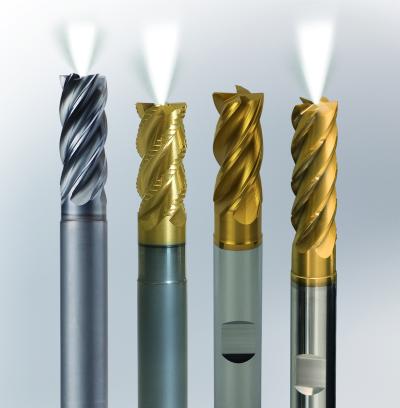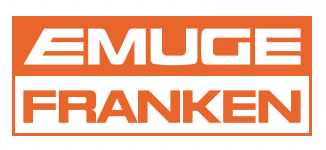
Emuge Corp. today announced the expansion of its EMUGE-FRANKEN TiNox-Cut End Mills line, designed for high-performance machining of demanding materials such as Inconel/ nickel alloys, titanium and stainless steel found in aerospace and other challenging applications. Four TiNox-Cut End Mill series are now offered, including the new 5-Flute N, NF, Base, and Trochoidal tools.
5-Flute TiNox-Cut N: This new coolant fed series features 5 flutes for high feed rates, a raised land that increases chip clearance, and is ALCR-coated. It is a high-performance tool designed for roughing and finishing, especially suitable for materials such as titanium and titanium alloys.
TiNox-Cut NF: This high-performance series features a fine chip breaker design that reduces chip size while reducing cutting forces. The tool features a proprietary TiN/ TiALN coating in both coolant fed and solid designs and is ideal for semi-finishing difficult materials such as nickel alloys.
TiNox-Cut Base: The Base design is a material specific style tool with a proprietary TiN/ TiALN coating for roughing and finishing and is ideal for stainless and acid-resistant steels.
TiNox-Cut Trochoidal: Ideal for high metal removal rates, this tool series features a newly developed geometry, a proprietary TiN/ TiALN coating and a chip breaker edge, which combined, reduces stress and vibration when machining difficult materials such as titanium and stainless steel. All tools are coolant fed for maximum performance. Designed for trochoidal milling via the overlapping movement of circular paths, these tools can rough and finish mill over 30% faster than standard designs, while increasing tool life significantly.
EMUGE-FRANKEN TiNox-Cut End Mills are made from premium ultra-fine micro grain solid carbide with a maximized transverse rupture strength for high impact applications, and produce impressive results compared to conventional end mills. Advanced PVD-applied multi-layered coatings withstand excessive heat and provide superb wear resistance for longer tool life, and tool geometry is designed to produce minimal vibration when machining tough materials.
TiNox-Cut N, NF and Trochoidal End Mills are available in axial internal coolant-through capability for maximum chip evacuation and cooling ability. TiNox-Cut N and TiNox-Cut Trochoidal tools are available in both square-end and corner radius configurations. Weldon flat shank construction is available in both TiNox-Cut NF and TiNox-Cut Trochoidal tools, and is compatible with Emuge FPC Milling Chucks featuring an anti-pullout pin lock system. Overall, the expanded line includes tools that are available in inch sizes ranging from ¼ʺ to 1ʺ in diameter, and in stub, standard, long and extra-long lengths.
Contact Details
Related Glossary Terms
- alloys
alloys
Substances having metallic properties and being composed of two or more chemical elements of which at least one is a metal.
- chip clearance
chip clearance
In milling, the groove or space provided in the cutter body that allows chips to be formed by the inserts.
- clearance
clearance
Space provided behind a tool’s land or relief to prevent rubbing and subsequent premature deterioration of the tool. See land; relief.
- coolant
coolant
Fluid that reduces temperature buildup at the tool/workpiece interface during machining. Normally takes the form of a liquid such as soluble or chemical mixtures (semisynthetic, synthetic) but can be pressurized air or other gas. Because of water’s ability to absorb great quantities of heat, it is widely used as a coolant and vehicle for various cutting compounds, with the water-to-compound ratio varying with the machining task. See cutting fluid; semisynthetic cutting fluid; soluble-oil cutting fluid; synthetic cutting fluid.
- feed
feed
Rate of change of position of the tool as a whole, relative to the workpiece while cutting.
- flat ( screw flat)
flat ( screw flat)
Flat surface machined into the shank of a cutting tool for enhanced holding of the tool.
- flutes
flutes
Grooves and spaces in the body of a tool that permit chip removal from, and cutting-fluid application to, the point of cut.
- gang cutting ( milling)
gang cutting ( milling)
Machining with several cutters mounted on a single arbor, generally for simultaneous cutting.
- land
land
Part of the tool body that remains after the flutes are cut.
- milling
milling
Machining operation in which metal or other material is removed by applying power to a rotating cutter. In vertical milling, the cutting tool is mounted vertically on the spindle. In horizontal milling, the cutting tool is mounted horizontally, either directly on the spindle or on an arbor. Horizontal milling is further broken down into conventional milling, where the cutter rotates opposite the direction of feed, or “up” into the workpiece; and climb milling, where the cutter rotates in the direction of feed, or “down” into the workpiece. Milling operations include plane or surface milling, endmilling, facemilling, angle milling, form milling and profiling.
- milling machine ( mill)
milling machine ( mill)
Runs endmills and arbor-mounted milling cutters. Features include a head with a spindle that drives the cutters; a column, knee and table that provide motion in the three Cartesian axes; and a base that supports the components and houses the cutting-fluid pump and reservoir. The work is mounted on the table and fed into the rotating cutter or endmill to accomplish the milling steps; vertical milling machines also feed endmills into the work by means of a spindle-mounted quill. Models range from small manual machines to big bed-type and duplex mills. All take one of three basic forms: vertical, horizontal or convertible horizontal/vertical. Vertical machines may be knee-type (the table is mounted on a knee that can be elevated) or bed-type (the table is securely supported and only moves horizontally). In general, horizontal machines are bigger and more powerful, while vertical machines are lighter but more versatile and easier to set up and operate.
- shank
shank
Main body of a tool; the portion of a drill or similar end-held tool that fits into a collet, chuck or similar mounting device.
- titanium aluminum nitride ( TiAlN)
titanium aluminum nitride ( TiAlN)
Often used as a tool coating. AlTiN indicates the aluminum content is greater than the titanium. See coated tools.
- wear resistance
wear resistance
Ability of the tool to withstand stresses that cause it to wear during cutting; an attribute linked to alloy composition, base material, thermal conditions, type of tooling and operation and other variables.

